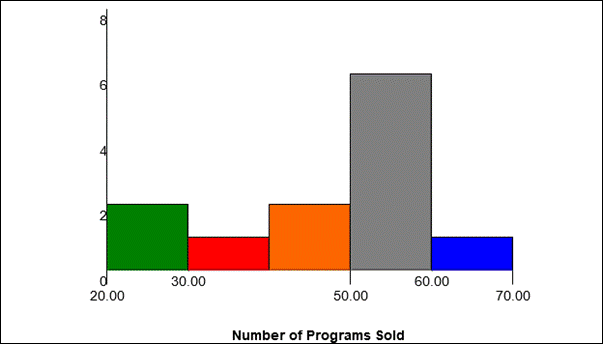
Concept explainers
a.
To calculate: The range of the number of programs sold.
a.
Answer to Problem 29E
The range is
Explanation of Solution
Given information:
Twelve students are selling programs at the Grove City High School to raise money for the athletic department. The numbers of programs sold by each student are
Formula used:
The range of a set of data is the difference between the greatest and the least values in the set.
Calculation:
Consider the data in ascending order ,
So,
The greatest value in the set is
The least value in the set is
The range is −
Hence, the range is
b.
To calculate: The class interval.
b.
Answer to Problem 29E
The class interval is 10 points.
Explanation of Solution
Given information:
Twelve students are selling programs at the Grove City High School to raise money for the athletic department. The numbers of programs sold by each student are
Formula used:
The class interval is the range of each class.
Calculation:
Consider the data in ascending order ,
So,
An appropriate class interval is 10 points, beginning with 20 points and ending with 70 points. There will be five classes.
Hence, the class interval is 10 points.
c.
To calculate: The class limits.
c.
Answer to Problem 29E
The class limits are 20, 30, 40, 50, 60, and 70.
Explanation of Solution
Given information:
Twelve students are selling programs at the Grove City High School to raise money for the athletic department. The numbers of programs sold by each student are
Formula used:
The class limits of a set of data organized in a frequency distribution are the upper and lower values in each interval .
Calculation:
Consider the data in ascending order ,
So,
An appropriate class interval is 10 points, beginning with 20 points and ending with 70 points. There will be five classes.
The class limits are 20, 30, 40, 50, 60, and 70.
Hence, the class limits are 20, 30, 40, 50, 60, and 70.
d.
To construct: The frequency distribution of the data.
d.
Answer to Problem 29E
| Class Intervals | Tallies | Frequency |
| 2 | ||
| 1 | ||
| 2 | ||
| 5 | ||
|
| 2 |
Explanation of Solution
Given information:
Twelve students are selling programs at the Grove City High School to raise money for the athletic department. The numbers of programs sold by each student are
Formula used:
The class limits of a set of data organized in a frequency distribution are the upper and lower values in each interval .
Calculation:
Consider the data in ascending order ,
So,
An appropriate class interval is 10 points, beginning with 20 points and ending with 70 points. There will be five classes.
The class limits are 20, 30, 40, 50, 60, and 70.
| Class Intervals | Tallies | Frequency |
| 2 | ||
| 1 | ||
| 2 | ||
| 5 | ||
|
| 2 |
Hence, the above table ids the frequency distribution of the data.
e
To sketch: The histogram of the data.
e
Explanation of Solution
Given information:
Twelve students are selling programs at the Grove City High School to raise money for the athletic department. The numbers of programs sold by each student are
Graph:

Figure 1.
Interpretation:
The graph represent the number of programs sold by each student. The maximum score is 68 and the minimum score is 23. The interval size is 10.
Chapter 14 Solutions
Advanced Mathematical Concepts: Precalculus with Applications, Student Edition
Additional Math Textbook Solutions
Basic Business Statistics, Student Value Edition
University Calculus: Early Transcendentals (4th Edition)
Intro Stats, Books a la Carte Edition (5th Edition)
Introductory Statistics
Elementary Statistics: Picturing the World (7th Edition)
A First Course in Probability (10th Edition)
 Calculus: Early TranscendentalsCalculusISBN:9781285741550Author:James StewartPublisher:Cengage Learning
Calculus: Early TranscendentalsCalculusISBN:9781285741550Author:James StewartPublisher:Cengage Learning Thomas' Calculus (14th Edition)CalculusISBN:9780134438986Author:Joel R. Hass, Christopher E. Heil, Maurice D. WeirPublisher:PEARSON
Thomas' Calculus (14th Edition)CalculusISBN:9780134438986Author:Joel R. Hass, Christopher E. Heil, Maurice D. WeirPublisher:PEARSON Calculus: Early Transcendentals (3rd Edition)CalculusISBN:9780134763644Author:William L. Briggs, Lyle Cochran, Bernard Gillett, Eric SchulzPublisher:PEARSON
Calculus: Early Transcendentals (3rd Edition)CalculusISBN:9780134763644Author:William L. Briggs, Lyle Cochran, Bernard Gillett, Eric SchulzPublisher:PEARSON Calculus: Early TranscendentalsCalculusISBN:9781319050740Author:Jon Rogawski, Colin Adams, Robert FranzosaPublisher:W. H. Freeman
Calculus: Early TranscendentalsCalculusISBN:9781319050740Author:Jon Rogawski, Colin Adams, Robert FranzosaPublisher:W. H. Freeman
 Calculus: Early Transcendental FunctionsCalculusISBN:9781337552516Author:Ron Larson, Bruce H. EdwardsPublisher:Cengage Learning
Calculus: Early Transcendental FunctionsCalculusISBN:9781337552516Author:Ron Larson, Bruce H. EdwardsPublisher:Cengage Learning





